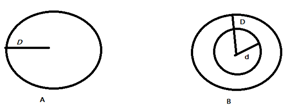Assertion & Reason Test: Mechanical Properties of Solids - ACT MCQ
12 Questions MCQ Test - Assertion & Reason Test: Mechanical Properties of Solids
Read the assertion and reason carefully to mark the correct option out of the options given below:
Assertion: The stretching of a coil is determined by its shear modulus.
Reason: Shear modulus change only shape of a body keeping its dimensions unchanged.
Read the assertion and reason carefully to mark the correct option out of the options given below:
Assertion : Steel is more elastic than rubber.
Reason : Under given deforming force, steel is deformed less than rubber.
Read the assertion and reason carefully to mark the correct option out of the options given below:
Assertion : A hollow shaft is found to be stronger than a solid shaft made of same material.
Reason : The torque required to produce a given twist in hollow cylinder is greater than that required to twist a solid cylinder of same size and material.
Read the assertion and reason carefully to mark the correct option out of the options given below:
Assertion : Strain is a unitless quantity.
Reason : Strain is equivalent to force.
Read the assertion and reason carefully to mark the correct option out of the options given below:
Assertion : Two identical solid balls, one of ivory and the other of wet-clay are dropped from the same height on the floor. Both the balls will rise to same height after bouncing.
Reason : Ivory and wet-clay have same elasticity.
Read the assertion and reason carefully to mark the correct option out of the options given below:
Assertion : Identical springs of steel and copper are equally stretched. More work will be done on the steel spring.
Reason : Steel is more elastic than copper.
Read the assertion and reason carefully to mark the correct option out of the options given below:
Assertion : Spring balances show correct readings even after they had been used for a long time interval.
Reason : On using for long time, spring balances losses its elastic strength.
Read the assertion and reason carefully to mark the correct option out of the options given below:
Assertion : Glassy solids have sharp melting point.
Reason : The bonds between the atoms of glassy solids get broken at the same temperature.
Read the assertion and reason carefully to mark the correct option out of the options given below:
Assertion : Bulk modulus of elasticity (K) represents incompressibility of the material.
Reason : Bulk modulus of elasticity is proportional to change in pressure.
Read the assertion and reason carefully to mark the correct option out of the options given below:
Assertion : The bridges declared unsafe after a long use.
Reason : Elastic strength of bridges losses with time.
Read the assertion and reason carefully to mark the correct option out of the options given below:
Assertion : Young's modulus for a perfectly plastic body is zero.
Reason : For a perfectly plastic body, restoring force is zero.
Read the assertion and reason carefully to mark the correct option out of the options given below:
Assertion : Stress is the internal force per unit area of a body.
Reason : Rubber is less elastic than steel.















